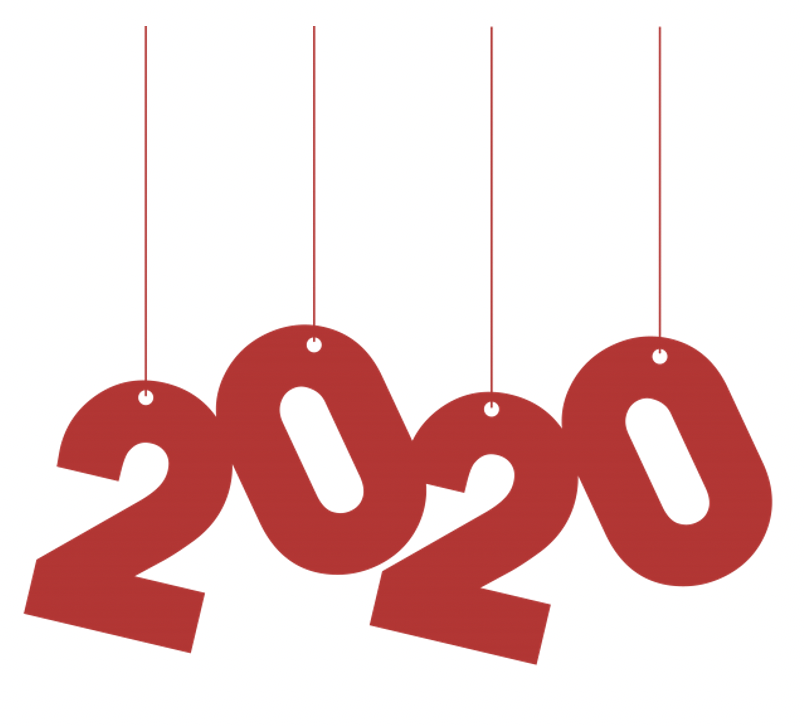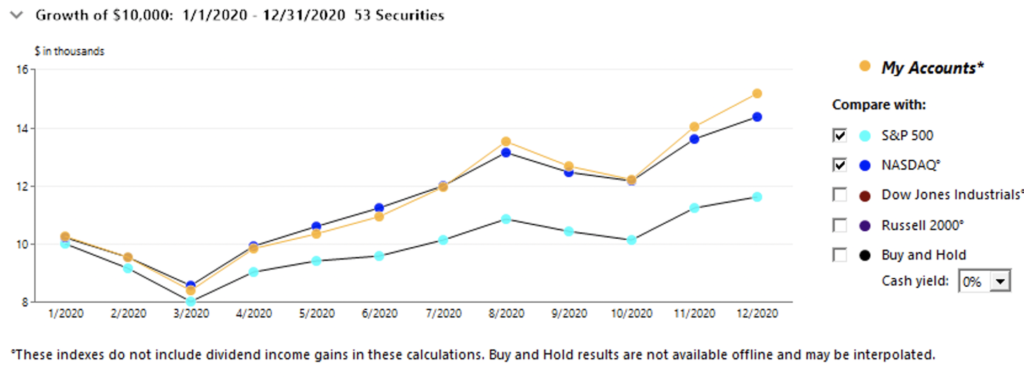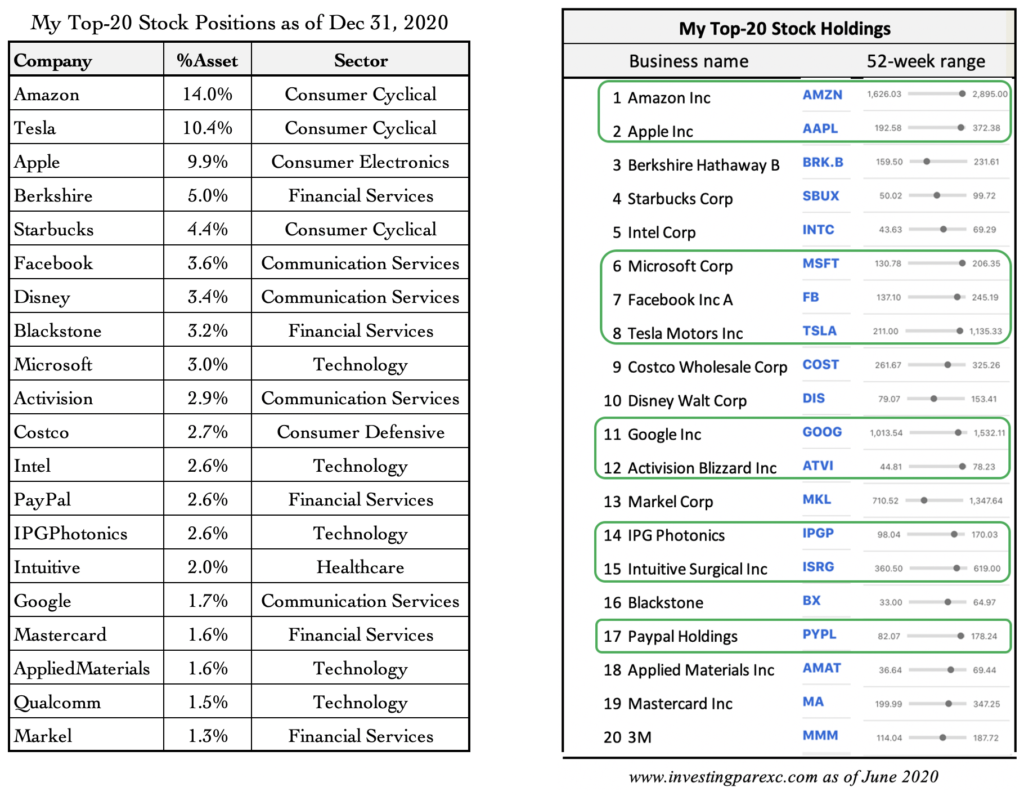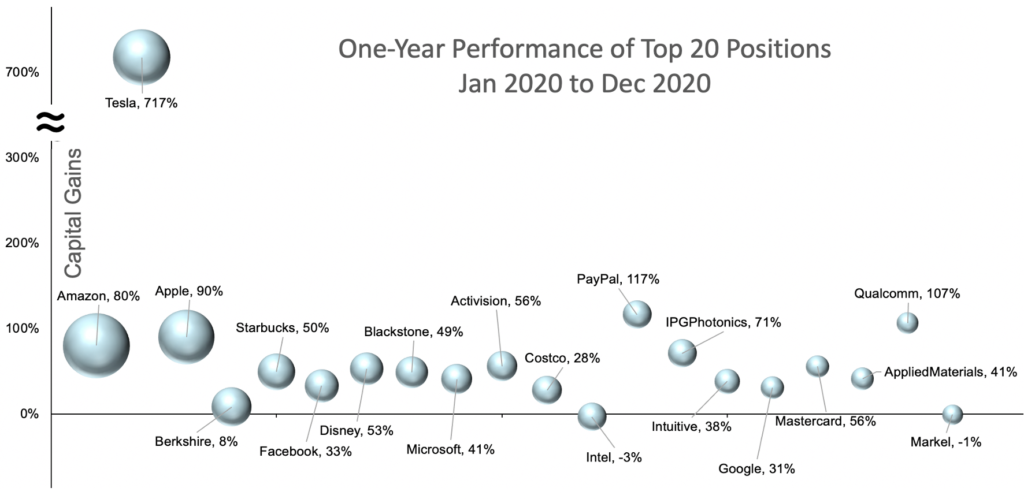After taking a short hiatus in January, I am back. Happy belated new year, everyone!

So this month I start off with end-of-year update of my stock holdings. In my mid-year update post (Breaking out to a new high) in July last year, I pointed out that my portfolio had reached an all-time high. Since then, the stock market has been going up, and so has my portfolio. See the chart below.

My year-end gain was 52%, not counting dividends. For the same period, the S&P 500 index returned only 16%. My outperformance is 3x. On the other hand, the technology laden NASDAQ index came closer. It gained 46% for the year—about 6% underperformance to my holdings.
Clearly, I did pretty well last year. But I don’t put much emphasis on single-year performance, and neither is my goal to beat the S&P 500 or NASDAQ indexes. Though it’s always good to study past performance and see if I can learn something from it.
I attribute my 2020 outperformance to two factors. One, my major positions did quite well, as you will see in a later chart. But even more importantly, I bought more of those stocks when they were on sale in April/May last year. I wrote about what I bought in this blog post from March.
I keep dry powder cash for market panics like we had in the second quarter last year. Those April stock purchases were part of my dry powder deployments. And they served me well as the stock market recovered later in the year.
From the chart, you can see how my portfolio started pulling away from the S&P 500 in March (that’s when I started adding to my positions) and the gap widened rapidly as market recovered.
It’s true that today half of my major positions are in mega-cap technology and communication services stocks. Those did very well last year. My top-20 holdings as of Dec 31st 2020 are in the table below. Today, these top-20 holdings make up 80% of my overall stock portfolio (making it a good exhibit of the 80-20 Pareto rule). For comparison, the right-hand table show my top-20 positions from June 2020 (first shared in this post):

Not much has changed since June except some of the positions have moved around. 3M dropped out of the list (though I haven’t sold it). It was replaced by Qualcomm. The remaining are all still there. One notable move has been in Tesla. It went from #8 on the list in June to #2 in December.
Tesla stock had a fabulous last year. I didn’t add to my position in Tesla during the year, but my existing position gained about 8x in twelve months. I plan to write more about Tesla in a separate blog post soon.
The following bubble chart shows performance of each individual position. Size of each bubble indicates relative weight of that holding in my portfolio. Height shows how much each gained in 2020.

As I said earlier Tesla was in a league of its own last year, gaining more than 8x for me. Next were a handful of companies that doubled or nearly doubled in my portfolio. This group includes familiar names like Amazon and Apple. And two less common names were Qualcomm and PayPal. You can see from bubble sizes that both Amazon and Apple are already among my top positions.
In the middle were about a dozen other businesses that gained 30 to 70% in the year. These include companies like Starbucks, Disney, Blackstone, Activision, and Costco. All are good businesses to keep for the long term. Marking the bottom were three stocks—two of which (Markel and Intel) lost a bit of ground while the veritable Berkshire Hathaway gained only about 8%.
I am not worried about the laggards though. They are still good businesses that I plan on keeping in my portfolio. Every year I expect some underperformers. Last year financial stocks in general did not do well. That explains Markel and Berkshire underperformance. Intel has some company-specific issues that held it down. All three have sound durable businesses, so I plan to keep them.
For this post, I only looked at my individual stock holdings. These individual stocks make up a big portion of my overall portfolio (about 55%) but I do have other assets like cash, index funds, and options and real-estate. See this post for the rest of my portfolio.
Hi
thanks for publishing your performance for 2020
I am interested in your comments about not being worried about laggards (penultimate paragraph)
I have come round to the view, that while a business may be sound, there is an opportunity cost to remaining invested in sound businesses as opposed to investing in growth businesses with high returns on capital, which are likely to provide a better return
To use a simple analogy, why leave money in a savings account paying 1% when you can invest it in an account and earn 3%
Hi, It’s a good question. To continue with your analogy, if I can get 3% “guaranteed” return then it would be stupid of me to keep money in a 1% account. But, and it is a big ‘but’, is that 3% return really so certain?
From my POV, 1-year perf laggards are not too concerning. Why? Several reasons: (1) Not all my stocks can realistically beat an index year in and year out. So I focus on business fundamentals much more so than yearly stock performance.
(2) I am happy with my laggards *so long as* their business quality is still excellent. Price performance over time converges with business results.
(3) Whenever I sell, I just guaranteed myself extra taxes. But there is no guarantee of superior performance from the new buys!
For more of my thoughts on this topic, see the following two posts:
Buy right, sell never: https://www.investingparexc.com/2020/01/06/buy-right-sell-never/
When do I exit stock positions: https://www.investingparexc.com/2018/08/26/when-do-i-exit-stock-positions/
Thanks emcee
all that makes sense
I am in the fortunate position that through patient accumulation over many years almost all my stock holdings are sheltered from tax, being either in my SIPP (self invested pension plan = IRA) or our ISA accounts (I don’t think you have these in the US), so tax on selling is not really a consideration
And certainly as the latest rotation has shown, laggards can suddenly become stars
I don’t think that affects my general investment approach – stated above – but I appreciate your view
Sounds good! You are certainly in an enviable position with all your stock holdings tax sheltered. Myself, I have about half of my assets in tax sheltered accounts.
There is certainly an opportunity cost when staying with current position and passing over an enticing prospect.